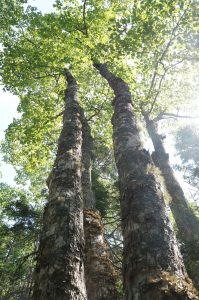Two letters in the May 2017 issue of Atlantic Forestry Review reflect on N.S. Crown land management issues.
 Tom Miller of Green Hill, N.S. focusses on the need for better management of Crown land hardwoods, not that softwoods don’t also need it, he says, but because he is tired of fighting that [softwood] battle. “Let’s start the conversation about how to revive the rural areas and do a better job of managing our hardwood resources.
Tom Miller of Green Hill, N.S. focusses on the need for better management of Crown land hardwoods, not that softwoods don’t also need it, he says, but because he is tired of fighting that [softwood] battle. “Let’s start the conversation about how to revive the rural areas and do a better job of managing our hardwood resources.
“Firstly, take all crown land hardwood out of the softwood users’ control. They don’t use it, and have a low regard and understanding of it. All the hardwood. Red maple and white birch can make high value products; they just need an “understanding champion” on their side….Set up a separate department in DNR to look after this segment and promote this value-added industry. Find new management people, because the present ones are softwood people with the short rotation view. This will be a truly long-term vision, with a 100-300 year time frame…Don’t think in terms of a large mill with two or three shifts per day. We need small- to medium-sized operations of 10-30 people spread around the province in small town areas.”
Small woodlot owner Frank Thomas of Annapolis Co. comments on “a movement by concerned citizens here in southwest Nova Scotia to look more closely at the proposed 10-year lease of crown lands to WestFor”, noting that clearcutting is being conducted on “acidic, impoverished soils which characterize much of Southwest Nova Scotia” and that it’s a big deal; it’s big enough, he says that Annapolis County Council requested Premier McNeil to grant a one-year exclusion of Annapolis County Crown lands and Digby Co. may do the same.
When ordinary citizens get worked up enough to pressure their politicans about a situation like this, you can bet this is not just the work of some poorly informed tree-huggers who view all forestry workers as pirates with chainsaws.
Thomas says “Our government has to get smarter about sponsoring and signing these stupid deals, and our regulatory environment needs to be robust enough sothat these deals just can’t happen.
There is a lot more in both of these letters that can’t be neatly paraphrased or covered in a few quotes and lot’s more that’s worth reading in AFR with it news items, topical articles and a pretty even coverage of different perspectives on forests and forestry. The print-only Atlantic Forestry Review is published six times per year “for independent woodlot owners in the four provinces of Atlantic Canada”. The current subscription rate is $20/year for in-Canada subscribers, a bargain indeed.
—–
As noted under About this site, “The Home Page for this website consists of “posts” and is intended to serve as a record of events, news and opinions on the subject of forests and forestry in Nova Scotia as they unfold, beginning on June 21, 2016.”
To view past posts reporting on Letters and Editorials, click on Letters&Editorials under Categories on the right panel of this page, or click here. I am sure I have missed a few or quite a few, but I do not filter on the basis of whether I agree with them or not (although I may comment on them), so the compilation should provide some sense of the back and forth about forestry in Nova Scotia in the Editorials and Letters to the Ed.
